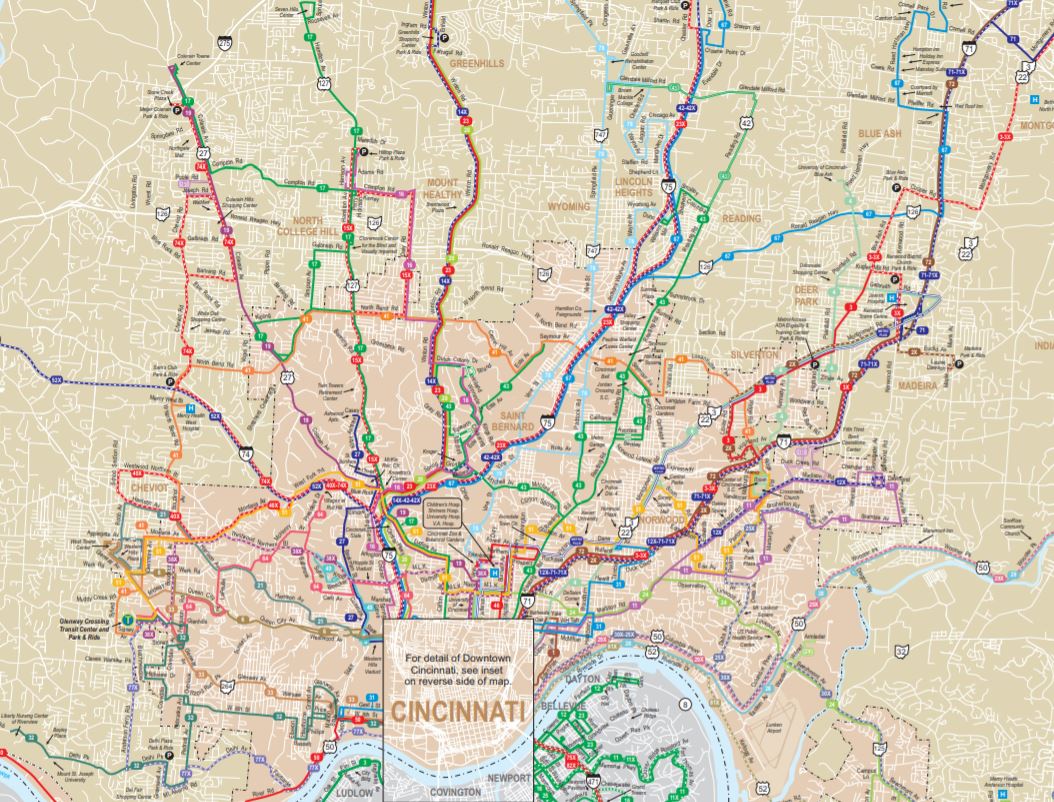By Rowan Grisez
Walnut Hills seems like the perfect place for a transit center. Like Northside, Walnut Hills is a hub of activity with direct access to downtown and uptown neighborhoods. The area boasts many restaurants and shops, with a strong, diverse community at the heart of it all. The issue is that, much like Northside, the area is already very dense. In many ways, this is a good issue for a transit center candidate to have. There is a built-in demand for transit access among the residents of the neighborhood, and a myriad of destinations for those looking to experience what Walnut Hills has to offer. It does, however, severely restrict the number of viable locations for such a project. This problem is at the heart of the current proposal to build a transit center on William Howard Taft Rd between Gilbert Ave and Kemper Ln.
The location is excellent for a number of reasons. It already sees the convergence of several existing routes, namely the 1, 4, 11, and 31. There is a laundromat, a library, two CPS schools, a recreation center, restaurants, a brewery, a grocery store, and convenience stores. All of this to say, there really isn’t a better spot for a transit center in this neighborhood. The only snag with the current proposal is what currently resides there: the Taft Community Garden. Advocates have been reluctant to part with the current garden, though some of them welcome a transit center in the area. Metro has heard their concerns, and responded with compassion and a desire to work collaboratively with local leaders. So, what can be done to meet the needs of the community while also continuing Metro’s efforts to expand our transit system?
Unfortunately, there is little chance that Metro will consider moving the parking lot to another location. The money has already been spent on the current plans, and any reconsideration would only add to the cost of redevelopment, both in terms of time and money. In light of this, community leaders have opted to promote the value of the garden and stress the importance of replacing it before construction begins. The first and most obvious benefit is that the produce grown in the garden is a lifesaver for those experiencing food insecurity. The Walnut Hills Redevelopment Foundation, which manages the garden, and La Soupe collaborate to distribute produce and chef-prepared meals to over 100 residents every week next to the Taft Garden. The garden itself provides free garden beds to interested neighbors where they can grow veggies, culinary herbs, and flowers that anyone is welcome to harvest. Aside from the actual food grown there, the garden itself serves as a space for neighbors to meet each other and create lifelong connections. Having that third space also gives residents a connection to Walnut Hills, even if they find their first or second spaces in jeopardy. The garden collaborates with local schools as well, providing education and opportunity for students within the community.
All of this to say that the garden is truly connected to every facet of life in Walnut Hills. As such, it is imperative that a garden remains a fixture of Walnut Hills. Metro understands this, and, while they haven’t made any proposals for a new garden location, they have committed to making sure that the community has the resources necessary to relocate when the time comes. The gardeners and community leaders haven’t found a definite replacement, either, but they are working toward finding a new location, and will share it with Metro once they’ve come to a consensus. All it would take to seal the deal is a talk between Metro, the gardening community, and the current property owners, and the new garden could become an integral part of this larger redevelopment plan.
As a parting thought, I’d like to make a direct plea to Metro. Please, if you are going to displace the garden, don’t let it be in vain. I hope I have made a decent case for the value of the community garden, but I also want to implore that the transit center which replaces it is more than just a one-and-done project. The original design contained far less greenery and activity space, and Metro has since amended their design to be a better asset for the residents of Walnut Hills. That shows good initiative, but the transit center needs to keep giving back to the community even after it's built. Whether that means expanding service to other lines, creating new ones to bridge the gap between the East and West sides, or even being an anchor for a second streetcar line between Clifton and Walnut Hills, the residents want to see the space continue to bring value to their community. They also want to ensure that the rest of their bus infrastructure sees the same amount of care and attention that has been put into this project so far. If Metro really wants to show their devotion to the community, they must keep this at the forefront of their minds as they move forward with this project.
Special thanks to the Walnut Hills Redevelopment Foundation for providing insights on the garden, neighborhood, and communications with Metro.















